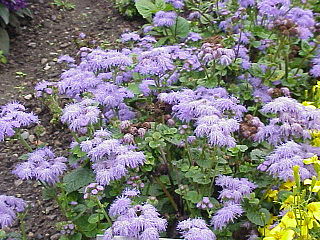Harold Ernest Robinson was an American botanist and an entomologist.

Eupatorium is a genus of flowering plants in the family Asteraceae, containing from 36 to 60 species depending on the classification system. Most are herbaceous perennials growing to 0.5–3 m (1.6–9.8 ft) tall. A few are shrubs. The genus is native to temperate regions of the Northern Hemisphere. Most are commonly called bonesets, thoroughworts or snakeroots in North America. The genus is named for Mithridates Eupator, king of Pontus.

Eupatorieae is a tribe of over 2000 species of plants in the family Asteraceae. Most of the species are native to tropical, subtropical, and warm temperate areas of the Americas, but some are found elsewhere. Well-known members are Stevia rebaudiana, a number of medicinal plants (Eupatorium), and a variety of late summer to autumn blooming garden flowers, including Ageratum (flossflower), Conoclinium (mistflower), and Liatris.

Bartlettina is a genus of flowering plants in the family Asteraceae. They are native to tropical regions of Mesoamerica and South America. The genus was erected to house several plants separated from genus Eupatorium.

Shinnersia rivularis, known as the Rio Grande bugheal or Mexican oak leaf plant, is an aquatic plant native to Texas, Coahuila, and Nuevo León.
Trichocoronis is a genus of North American aquatic plants in the tribe Eupatorieae within the family Asteraceae. Bugheal is a common name for plants in this genus.
Tamaulipa is a genus of flowering plants in the tribe Eupatorieae within the family Asteraceae.

Piqueria is a genus of Caribbean and Mesoamerican plants in the tribe Eupatorieae within the family Asteraceae.

Chromolaena ivifolia called ivy-leaf false thoroughwort, or ivyleaf thoroughwort, is a species of flowering shrub in the family Asteraceae. It is native to North America and South America, from the south-eastern United States to Argentina.
Chromolaena frustrata called Cape Sable false thoroughwort, or Cape Sable thoroughwort, is a rare North American species of flowering shrub in the family Asteraceae. It is found only in southern Florida, on the Florida Keys, inside Everglades National Park, and other nearby low-lying areas. It grows on coastal rock outcrops, the edges of hammocks, and other undisturbed sites at elevations less than 10 meters above sea level.
Chromolaena bigelovii called Bigelow's false thoroughwort, or Bigelow's thoroughwort, is a North American species of flowering shrub in the family Asteraceae. It is native to northeastern Mexico and the US State of Texas.
Chromolaena borinquensis, the limestone thoroughwort, is a West Indian species of flowering shrub in the family Asteraceae. It is native to the Commonwealth of Puerto Rico, part of the United States.
Chromolaena geraniifolia, the geraniumleaf thoroughwort, is a West Indian species of flowering shrub in the family Asteraceae. It is native to the Commonwealth of Puerto Rico, part of the United States.
Chromolaena oteroi, the Mona Island thoroughwort, is a species of flowering shrub in the family Asteraceae. It has been found only on Mona Island, a small island between Puerto Rico and Hispaniola in the West Indies and politically a part of the Commonwealth of Puerto Rico.

Fleischmannia incarnata, the pink slender-thoroughwort or pink thoroughwort, is a North American species of flowering plant in the family Asteraceae. It is native to the United States from Florida north as far as Virginia, Ohio, and Illinois, and west to Texas and Oklahoma. It is also found in northeastern Mexico.
Fleischmannia sonorae, the Sonoran slender-thoroughwort or Sonoran thoroughwort, is a North American species of flowering plant in the family Asteraceae. It is native to western Mexico from Sonora and Chihuahua as far south as Michoacán, as well as from the southwestern United States.
Flyriella parryi, the Chisos Mountain brickellbush, is a Mexican species of plants in the family Asteraceae. It is native to the states of Nuevo León, Coahuila, and Chihuahua in northern Mexico. It is the only species in its genus to have a natural range extending north of the international border, with a few populations on the Texas side of the Río Grande.
Koanophyllon palmeri, called Palmer’s umbrella thoroughwort, is a North American plant species in the family Asteraceae. It is native to Arizona, southwestern New Mexico, and western Mexico from Sonora as far south as Michoacán.
Koanophyllon villosum, the Florida Keys thoroughwort, or abre camino, is a species of flowering plant in the family Asteraceae. It grows in southern Florida, Cuba, the Bahamas, Hispaniola, Jamaica, and the Islas de la Bahía.
Koanophyllon dolicholepis is a species of flowering plant in the family Asteraceae. It is found only in Puerto Rico.






